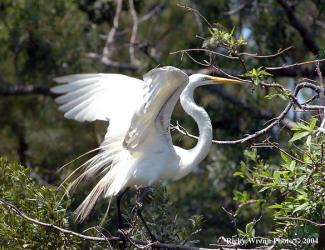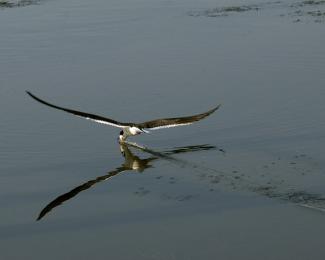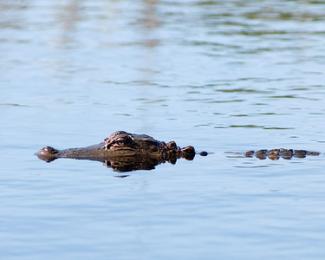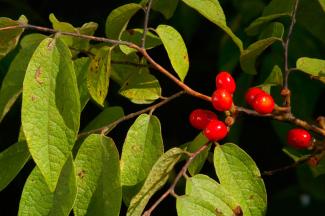Animals

Plants and Wildlife on the Francis Marion National Forest
More than 1,600 species of plants have been documented on the Francis Marion National Forest, including 32 species of orchids, 22 species of ferns, and 12 species of carnivorous plants. Approximately 48 species of mammals, 250 species of birds, 43 species of amphibians and 58 species of reptiles are known to inhabit the forest.
Wildflower viewing on the Francis Marion is engaging through nearly every season of the year.
Due to its significance to resident and migratory birds, the Francis Marion has been designated as an Important Bird Area by both the National Audubon Society and the American Bird Conservancy. Important Bird Areas are defined as sites that have been documented to support significant populations of particular species or a significant diversity of species. The Francis Marion provides essential stopover habitat for autumn and spring migrating birds, as well as critical breeding habitat. Two species known to occur on the Francis Marion and listed on the National Audubon’s red list include the red-cockaded woodpecker (RCW) and Bachman’s sparrow (Aimophila aestivalis). Both species can be found on the forest with great regularity.
Approximately 12 species of migratory birds listed on the National Audubon’s yellow list have been documented on the forest as well. Significant numbers of species with high conservation priority such as the black-throated green warbler (Dendroica virens), Swainson’s warbler (Limnothlypis swainsonii), prothonotary warbler (Protonotaria citrea), worm-eating warbler (Helmitheros vermivora), brown-headed nuthatch (Sitta pusilla), RCW, Chuck-will’s Widow (Caprimulgus carolinensis), wood duck (Aix sponsa), and northern parula (Parula Americana) have also been documented.
The swallow-tailed kite, a state endangered species, is frequently seen soaring over the forest with its long forked tail. The bird is known to nest 60-130 feet up in trees throughout the forest.

The red-cockaded woodpecker population has made a tremendous recovery since Hurricane Hugo devastated the forest in 1989. Today the forest functions as a donor population to help establish the birds in other locations.
The American black bear (Ursus americanus) continues to make its home on the Francis Marion. As the bears continue to lose habitat on private lands, the forest will serve as one of the last strongholds for the species in the area. Other mammals more commonly encountered include otters, beavers, coyotes, bobcats, raccoons and deer.
Perhaps one of the most often asked about creatures found on the Francis Marion is the American alligator. These reptiles are active year round, but are most active in the summer months, and can be found in swamps, rivers and ponds. Though primarily freshwater creatures, they will venture into brackish waters from time to time.

Numerous snakes, both venomous and non-venomous make their home in the forest and its swamps. The venomous ones include: the eastern cottonmouth; the southern copperhead; the eastern diamondback rattlesnake; the timber rattlesnake; the Carolina pygmy rattlesnake; and the eastern coral snake.
The Forest Service cooperates with the US Fish and Wildlife Service in conserving federally listed proposed, endangered, threatened and sensitive (PETS) species, by conducting activities and programs to assist in the identification and recovery of these species. Sensitive species are species identified by the Regional Forester as showing significant declines in population numbers, density, or habitat capability that could reduce the species’ existing distribution. The management goal for a sensitive species is to prevent it from becoming so rare that it is federally listed.
Plants and Wildlife on the Sumter National Forest
The Sumter National Forest lies within both the Blue Ridge and the piedmont where variations in elevation lead to differences in the vegetation that grows there. The Andrew Pickens Ranger District is located along the Blue Ridge where you will find a mixture of shortleaf pine with various hardwoods on low elevation ridges and south-facing slopes. Pitch pine and table mountain pine are found on high ridges. Mesic oak-hickory forests are found on lower and north-facing slopes. Mixed mesophytic and white pine–hemlock forests are located in forested coves.
The Long Cane and Enoree Ranger Districts, in the piedmont, are predominantly loblolly pine forests interspersed with patches of upland hardwoods, including sweetgum, white oak, southern red oak, hickories, yellow-poplar, red maple, and various other oaks.
Wildflower viewing is possible in diverse pockets throughout the Sumter National Forest from spring through fall, if you know where to look.

The districts offer a wide variety of plants including walking fern, nodding trillium, faded trillium, Shoal’s spider lily, Robin’s plantain, green-and-gold, mayapple, Canada violet, liverleaf, sweet Betsy’s trillium, foamflower, wild or spotted geranium and the rare sweet white trillium, just to name a few. Unfortunately, non-native invasive plant species can spread into and persist in native plant communities and displace native plant species, posing a threat to the integrity of the natural plant ommunities. Some of the non-native invasive plants known to severely impact native plant diversity on the Sumter National Forest include Japanese and Chinese privet, kudzu, sericea lespedeza, Japanese honeysuckle, Chinese wisteria, Japanese stiltgrass, tree of heaven, autumn olive, multiflora rose, mimosa and China Berry. Wildflower viewing is possible from spring through fall, if you know where to look.
You won't be disappointed with the abundance of wildlife on the Sumter National Forest that includes dove, quail, squirrel, opossum, fox, raccoon, rabbit, woodcock, deer, ruffed grouse, chipmunk, bats, black bear, beavers, coyotes, bobcats and wild turkey, just to name a few. If it's aquatic wildlife you're seeking, you can find largemouth bass, catfish, crappie, striped bass, redeye bass, catfish and bream in various streams and rivers throughout the forest.
Location is one of the advantages of birding on the Sumter National Forest. Many northern species reach the southern extent of their breeding range in the area and are not found elsewhere in the state, particularly on the Andrew Pickens Ranger District. If you're lucky, you may spot hooded warbler, scarlet tanager, pine warbler, acadian flycatcher, brown-headed nuthatch, prairie warbler, Swainson's warbler, field sparrow, American woodcock, pileated woodpecker, prothonotary warbler, wood duck, egrets and great blue heron, Bachman's sparrow, brown-headed nuthatch, red-eyed vireo, thrushes, ovenbird, yellow-throated warbler, cedar waxwing or Eastern bluebird.
Currently, more than 25 proposed, endangered, threatened or sensitive (PETS) species of flora and fauna are found on the Sumter National Forest.


